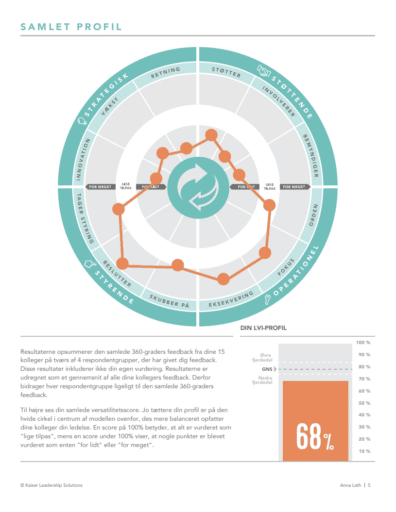Power in leadership is an explosive topic, but also a blurry and difficult phenomenon to grasp. Read here about how to distinguish between the forms of power and use them constructively.
Let's start with a current example of how the three forms of power work in practice. When Odense's mayor Anker Boye (consciously or unconsciously) agrees to raise the data roaming cap from DKK 100,000 to DKK 200,000 while on vacation in Turkey ,he is using his structural power , which islinked to his formal role as mayor. But at the same time, he is at risk of undermining his personal power, which is based on personal characteristics and resources. To understand this, we need to lookat the third form of power: discursive power, which operates through language via the meaning created for action in public narratives. We all live under the discursive power thatascribes meaning to our actions, giving them meaning in the social sphere. When Boye refers to unintentionality, he is trying to create a certain meaning around his behavior by explaining it with a less reprehensible personal attribute than if he had referred to deliberate waste ofpublic funds. He is thus trying to influence discursive power through his personal power. But we can only influence discursive power indirectly, which is why it is also outside Boye's direct sphere of influence.
Therefore, there is a risk that, despite Boye's efforts, the public may still predominantlyinterpret his behavior into a narrative (discourse) about politicians' greed and lack of civic-mindedness. If this happens, the underlying problem for Boye, which is the biggest threat to his to his personal power base, namely that he violates the close link between power and ethics. This is because, as Løgstrup tells us, the ethical does not consist of removing power (for example, giving Løkke a clothing budget or Boye a roaming cap), but in using power ethically. It is precisely from power that the ethical demand arises, and those who are given special power are thus also are also subject to a special ethical demand. Brinkmann (2014) puts it this way: If we get rid of power we also kill ethics. Anyone who does not have power over another's life cannot act on the other person's life.
In organizational literature, leadership is often defined as influencing and solving tasks through others (Elmholdt, Keller & Tanggaard, 2013). This understanding of leadership emphasizes the close and inseparable bond between leadership and power. Whether you as a leader use explicit, hard poweror the invisible, soft power, power is a basic condition in any leadership practice. There is neither more nor less power today. But power has taken on different forms and has therefore become moredifficult to spot . Leadership today takes place in a context of intersections and contradictions, and paradoxes are abasic condition. As a leader, you must therefore relate to the complex field of tension you find yourself in so that you can act in it in a way that is appropriate for yourself, your employees and theorganization. This requires a delicate balancing act, where you continuously deal with the integration of structural, personal and discursive power, as described below.
The power triangle - a power analysis tool
Historically, two main lines can be traced in the power literature: the power-over and power-to perspectives(Clegg et al. 2006). In the power-over perspective, the fundamental question iswho has power over whom. Thefocus is centered on the structure of power - i.e. whoformally holds power. The power-to perspective, on the other hand, is interested in what power does. How is powerexercised and what effects does power have on culture and individual consciousness . Thefield of power has been characterized by ongoing positioning struggles between these dimensions and approaches. Incontrast, we see it as a strength to use a multiple concept of power thatrefers to a broad spectrum of dimensions of power and influence . Thepurpose of this is to ensure an analytical and practical approach to power that is sufficiently open to what happens inleadership work. We want to highlight why power is not only a destructive phenomenon ,but also a constructive prerequisite for an organizational community. Power is not necessarily something that breaks down and locks in. An explicit focus on power can be productive for both organization and employees. But which form of power is at play when? And how should theleader act in the complex structures of power so that the organization can achieve the desiredresults? To understand your leadership practice and to be able to act on these questions , you need apractical framework to analyze, discuss and apply power.
With this in mind, we have developed the power triangle (see figure above), which integrates the following three main dimensions :
1. The structural approach focuses on formal structures that secure certain positions
power over others.
2. The personal approach focuses on personal attributes and resources.
3. The discursive approach focuses on linguistic and hidden power struggles.
The article continues in the section below.

Are you too controlling of your employees?
This is Denmark's only 360-degree evaluation of how your colleagues perceive your leadership style and behavior in the organization.
It gives you insights into how your superiors, subordinates and peers perceive you, while also providing concrete solutions on how to adapt your leadership style. This enables you to lead people more effectively as you can adapt your leadership style to specific situations and people around you.
You get direct feedback on others' perceptions of your ability to lead in the following four ways:
- Empowering leadership style
- Supportive leadership style
- Strategic management style
- Operational management style
Get detailed information about our LVI assessment and certification by filling out the form below.
Structural power
In the structural form of power, it makes sense to clarify and define your own formal management space, as it can make current options for action within the given organizational framework clearer. Management power here is about the formal management mandate, i.e. which decisions you aremandated to make, which management instruments you are required to use, which meeting forums you are obliged toattend, which guidelines and instructions you must follow, etc. Here you can ask yourself:
- What does the organization chart look like?
- What are the formal hierarchies like?
- Are the power structures appropriate for the task at hand?
- Is the management task sufficiently defined at the different management levels?
Personal power
Leadership power is just as much about the leader's own personal power. Your personal way of managing your power and the impact it has on the entire organization. Leadership power is largely externally given (structural power) and determined by context (discursive power), but you ,with your personal skills, experience, special characteristics and style, also have the opportunity to influence it and thus your own leadership space. When considering this, you can examine your own and others' power resources by asking questions , for example:
- Am I using my skills sufficiently?
- What is my preferred leadership style?
- What are my strengths and weaknesses as a leader?
- Are the power resources of others being used optimally for the common good of the organization?
Discursive power
Finally, power also works through the diverse and contradictory discourses. It manifests itself through the manager's and employees'jointly created language and perceptions of reality. Power is therefore also a relational matter. Clarifying your leadership space isthus very much about reflecting on social relations, informal structures and preferred ways of speaking by asking questions, among other things :
- What do we talk about in our organization - and how?
- What are the preferred opinions and narratives?
- And perhaps more tellingly: What are we not talking about?
Power and the future roles of leadership
The ideal of the leader as the helmsman, heroically guiding the ship safely into port across a turbulent sea, is in sharp retreat. The sea has simply become too turbulent and the port's purpose too unclear for thisideal to make sense in today's complex organizations. In the hierarchical, bureaucraticorganizations of thepast, thedistribution, terms and consequences of power were relatively clear. Thisis not the case in today's dialogically oriented "flat" organizations . Power hasbeen atomized, so that power no longer has a clear center or structure. Powerhas become diffuse and flexible, just like the emerging networked and team-organized companies (Fogsgaard & Elmholdt, 2014) .
Alongside this organizational evolution, we have in many ways developed a warped relationship with power in today's society. You could say that power has become alien to us, which can be seen when managers figuratively abdicate their leadership role to become "friends "or "colleagues" with employees. From an analytical perspective, it can be said that managers struggle to manage the power associatedwith the role in relation to the demands and expectations of autonomy and self-determination that are prevalent in today's society . Because it is increasingly rare for leaders to resort to formal and hard power, it is easy toassume that successful modern leadership does not include the exercise of power. It's vital to dispel this assumption. There is neither less power nor the exercise of power in modern organizational life. However, power has taken on different forms and has therefore become more difficult to spot. In modern leadership practices such as coaching and appreciative leadership ,the formal asymmetry isobscured and power ishidden. But power still has a function: thehidden power aims to shape employees in ways that benefit the organization's goals by ,for example, increasing their skills and coping abilities .
The article continues in the next section.
Get training in mental health and well-being management
With an education in psychological work environment and well-being management, you will be equipped with the most important management skills to prevent stress, reduce sick leave, increase well-being and optimize performance in your organization. You will:
- The most up-to-date knowledge in the field
- Knowledge to understand the connection between management and psychological work environment
- Tools and methods to develop and maintain a good psychological work environment in your organization
- Tools to manage and prevent stress
- Tools to create learning and develop employee performance

Fill out the form below to receive our course materials.
The leadership pendulum has swung in the direction of an engaging, appreciative and coaching leader. But at the same time, every leader knows that not all challenges are suitable for solving withparticipative and dialogical leadership tools. Current leadership tasks may sometimes require amore directive approach to setting direction. In certain situations, such as firing or hiring ,it becomes clear that leadership is a power-based relationship. This type of power is visible to everyone and highlights thestructural asymmetry between manager and employee.
If we are to understand and act in the complexity of the phenomenon of leadership, we must therefore include the three, sometimes opposing, dimensions of power. It would be an inappropriate reduction to favor one dimension at the expense of the others, and it would cut us off from understanding significant issues ofimportance. Most often, successful leadership requires that the leader is able to use raw structural power, the personal power base and discursive power.
To navigate this conflicting chaos, it is crucial that both managers and employees are aware of the power play, power relations and the function of power in the organization. Only then can you managers can assess when which forms of power are most appropriate: When to set direction and when to delegate? Different leadership roles each have their own function and justificationand justification, and in practice, roles are rarely crystal clear. The exercise is to consider what you do as a leader, why you do, why you do it and what the effect of what you do will be. There is no simple manual for good leadership. It is a practice that is best learned through experience and reflection.
References
Brinkmann, S. (2014). "Power and ethics in working life: Two sides of the same coin". In: Fogsgaard, M. &
Elmholdt, C. (2014). Power in organizations. Aarhus, Klim
Brinkman, S. (2011). "Emotions for better or worse". In: Elmholdt, C. & Tanggaard, L. (2011). Emotions in leadership. Aarhus, Klim
Clegg, S.R. (2002): Frameworks of Power. London, Sage Publications
Clegg, S.R., D. Courpasson & N. Phillips (2006): Power and Organizations. Thousand Oaks, CA, Sage Publications
Elmholdt, C., Keller, H.D. & Tanggaard, L. (2013). Management psychology. Samfundslitteratur. Frederiksberg
Fogsgaard, M. & Elmholdt, C. (2014). Power in organizations. Aarhus, Klim
Foucault, M. (1982): "The Subject and Power". IN: H.L. Dreyfus & P. Rabinow (eds.): Michel Foucault - Beyond Structuralism and Hermeneutics. Chicago, The University of Chicago Press
Foucault, M. (2002): Surveillance and punishment - the birth of the prison. Frederiksberg, Det lille Forlag
Visholm, S. (2004): "The authority relation". IN: T. Heinskou & S. Visholm: Psychodynamicorganizational psychology - at work beneath the surface. Copenhagen, Hans Reitzels Forlag
Yulk, G. (2013): Leadership in Organizations. Albany, Prentice Hall




